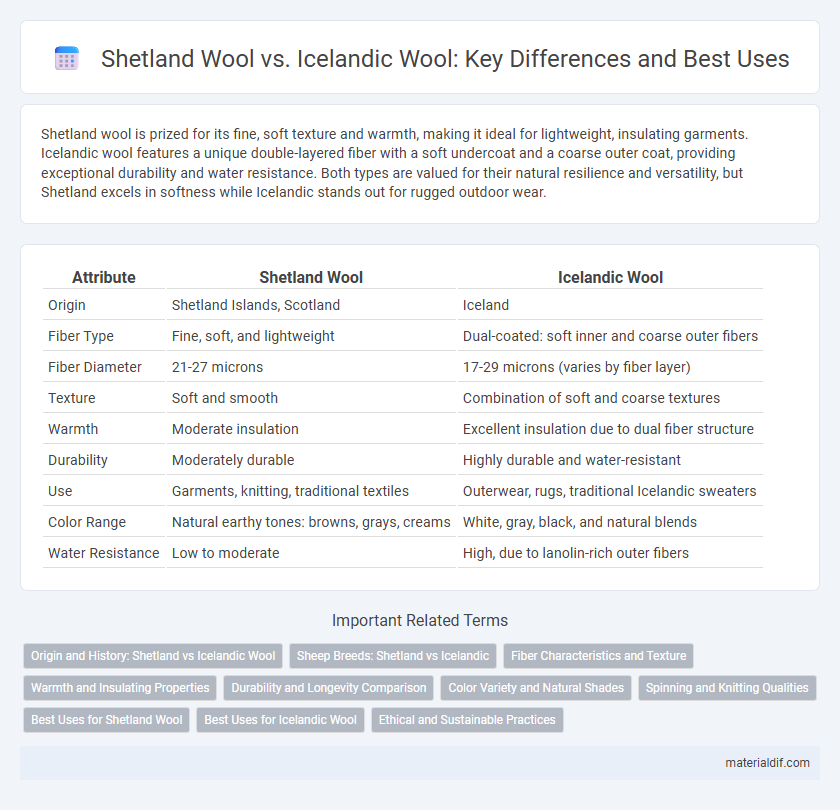Shetland wool is prized for its fine, soft texture and warmth, making it ideal for lightweight, insulating garments. Icelandic wool features a unique double-layered fiber with a soft undercoat and a coarse outer coat, providing exceptional durability and water resistance. Both types are valued for their natural resilience and versatility, but Shetland excels in softness while Icelandic stands out for rugged outdoor wear.
Table of Comparison
| Attribute | Shetland Wool | Icelandic Wool |
|---|---|---|
| Origin | Shetland Islands, Scotland | Iceland |
| Fiber Type | Fine, soft, and lightweight | Dual-coated: soft inner and coarse outer fibers |
| Fiber Diameter | 21-27 microns | 17-29 microns (varies by fiber layer) |
| Texture | Soft and smooth | Combination of soft and coarse textures |
| Warmth | Moderate insulation | Excellent insulation due to dual fiber structure |
| Durability | Moderately durable | Highly durable and water-resistant |
| Use | Garments, knitting, traditional textiles | Outerwear, rugs, traditional Icelandic sweaters |
| Color Range | Natural earthy tones: browns, grays, creams | White, gray, black, and natural blends |
| Water Resistance | Low to moderate | High, due to lanolin-rich outer fibers |
Origin and History: Shetland vs Icelandic Wool
Shetland wool originates from the Shetland Islands off Scotland's northeast coast, developed over centuries by the Shetland sheep breed known for its fine, soft, and durable fibers. Icelandic wool comes from Icelandic sheep, descendants of ancient Norse stock brought during Viking settlement in the 9th century, celebrated for its dual-coat structure combining a soft undercoat (thel) and a long, coarse outer hair (tog) offering superior insulation and water resistance. The historical isolation of both breeds has created unique wool characteristics, with Shetland wool prized for traditional Fair Isle knitting and Icelandic wool valued for its use in warm, weather-resistant garments.
Sheep Breeds: Shetland vs Icelandic
Shetland wool is renowned for its fine, soft texture and natural color variations, making it highly valued for lightweight, warm textiles. Icelandic wool combines two fleece types: the soft, insulating inner layer called "thel" and a coarser outer layer known as "tog," providing excellent water resistance and durability. While Shetland fleece is prized for delicate knitwear, Icelandic wool excels in outdoor garments due to its robust and dual-layered structure.
Fiber Characteristics and Texture
Shetland wool features fine, soft fibers with a staple length of 2 to 4 inches, offering a lightweight yet durable texture ideal for intricate knitting projects. Icelandic wool consists of dual fibers: a soft, insulating inner layer called "thel," and a longer, coarser outer layer named "tog," providing exceptional warmth and water resistance. The Shetland fiber is characterized by its elasticity and softness, while Icelandic wool emphasizes resilience and weather protection through its unique dual-layer structure.
Warmth and Insulating Properties
Shetland wool is renowned for its fine crimps and softness, providing excellent insulation by trapping air to retain warmth in cold climates. Icelandic wool features a unique dual coat with a soft, insulating undercoat and coarse outer fibers that offer superior water resistance and windproof benefits. Both types excel in warmth retention, but Icelandic wool is preferred for harsher, wetter conditions due to its moisture-wicking and durable properties.
Durability and Longevity Comparison
Shetland wool is renowned for its fine, soft texture combined with exceptional durability, making garments long-lasting and resistant to wear. Icelandic wool stands out for its unique dual-layer structure, offering outstanding longevity through its resilient outer coat and warm, insulating inner fleece. Both types provide impressive durability, but Icelandic wool's combination of strength and water resistance often surpasses Shetland in prolonged harsh weather conditions.
Color Variety and Natural Shades
Shetland wool is celebrated for its rich palette of natural shades, ranging from soft creams and warm browns to deep fawns and grays, offering a diverse and earthy color variety. Icelandic wool contrasts with its distinctive dual coat, featuring a broader spectrum that includes bright whites, cream tones, slate grays, and bold blacks. The color variety in Shetland wool often reflects traditional pastoral hues, while Icelandic wool presents more striking contrasts due to its unique fiber structure.
Spinning and Knitting Qualities
Shetland wool is prized for its fine, soft texture and strong elasticity, making it ideal for intricate spinning and lightweight, durable knitting projects. Icelandic wool offers a dual-layer structure with a coarse outer layer and a soft inner layer, providing excellent warmth and water resistance, perfect for robust, textured knits and sturdy yarn. Both wools produce versatile fibers, but Shetland excels in delicate lacework while Icelandic wool is preferred for resilient, insulating garments.
Best Uses for Shetland Wool
Shetland wool is renowned for its fine, soft texture and excellent warmth, making it ideal for lightweight garments such as sweaters, shawls, and baby clothes that require delicate insulation. Its natural elasticity and durability excel in producing traditional Fair Isle knitting patterns and intricate lacework, where stitch definition is key. Unlike coarser Icelandic wool, Shetland wool's versatility supports both wearable fashion and fine crafts, prized by hand knitters and textile artisans worldwide.
Best Uses for Icelandic Wool
Icelandic wool is best suited for outdoor garments due to its combination of fine, insulating inner fibers and durable, water-resistant outer fibers, making it ideal for sweaters, hats, and mittens designed for wet and cold climates. Unlike Shetland wool, which excels in softness and traditional fabric uses, Icelandic wool's unique dual-layer structure provides superior warmth and moisture management. Its resilience and lightweight nature make it perfect for performance wear and traditional Icelandic lopapeysa sweaters.
Ethical and Sustainable Practices
Shetland wool is renowned for its sustainable harvesting, as Shetland sheep graze on natural pastures without chemical fertilizers or pesticides, promoting biodiversity. Icelandic wool comes from sheep that roam free in pristine environments, ensuring ethical animal treatment and minimal environmental impact through traditional hand-spinning and organic farming techniques. Both wools emphasize eco-friendly practices, but Shetland's local community-driven initiatives contrast with Iceland's emphasis on maintaining ancient, sustainable pastoral methods.
Shetland vs Icelandic Infographic

 materialdif.com
materialdif.com